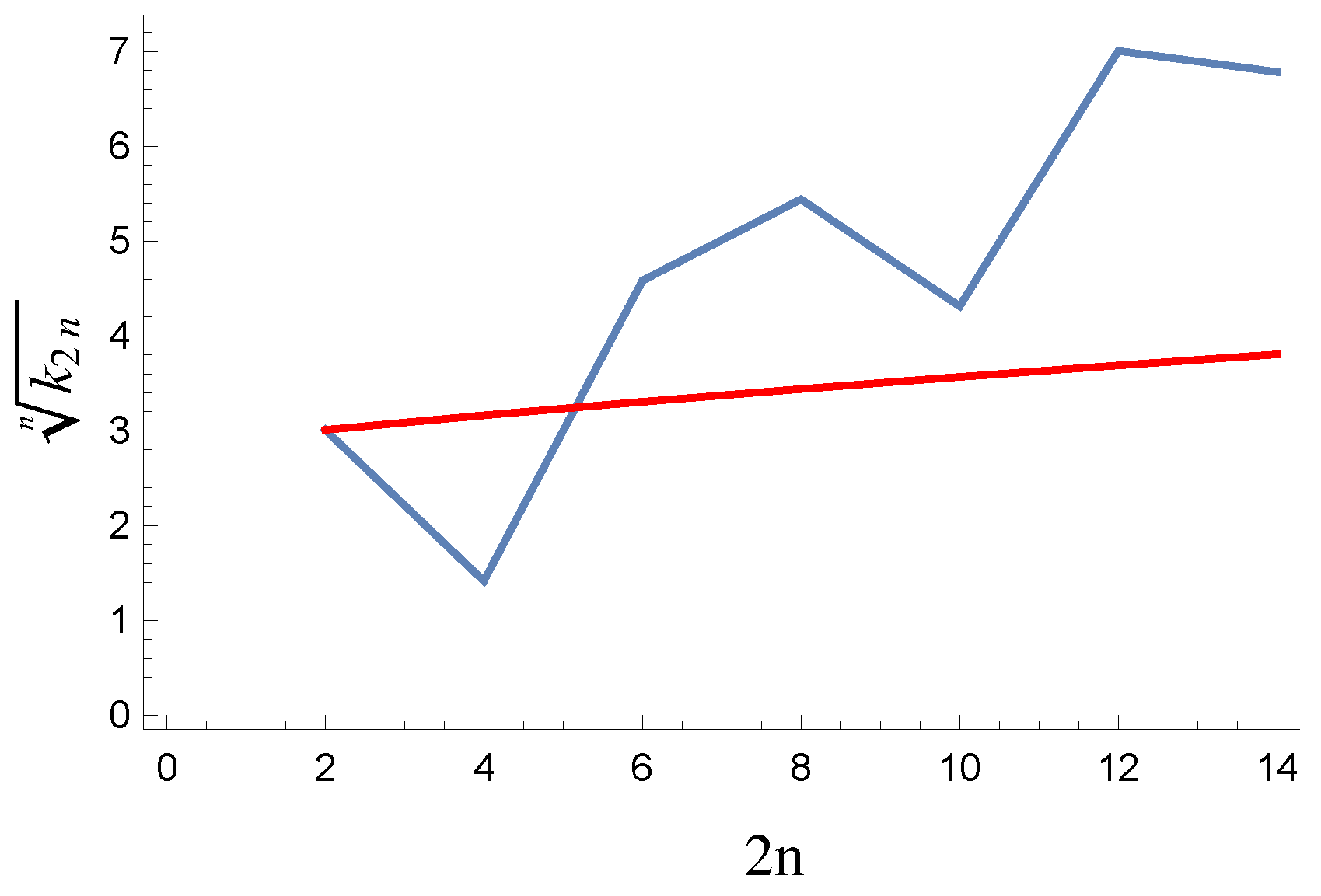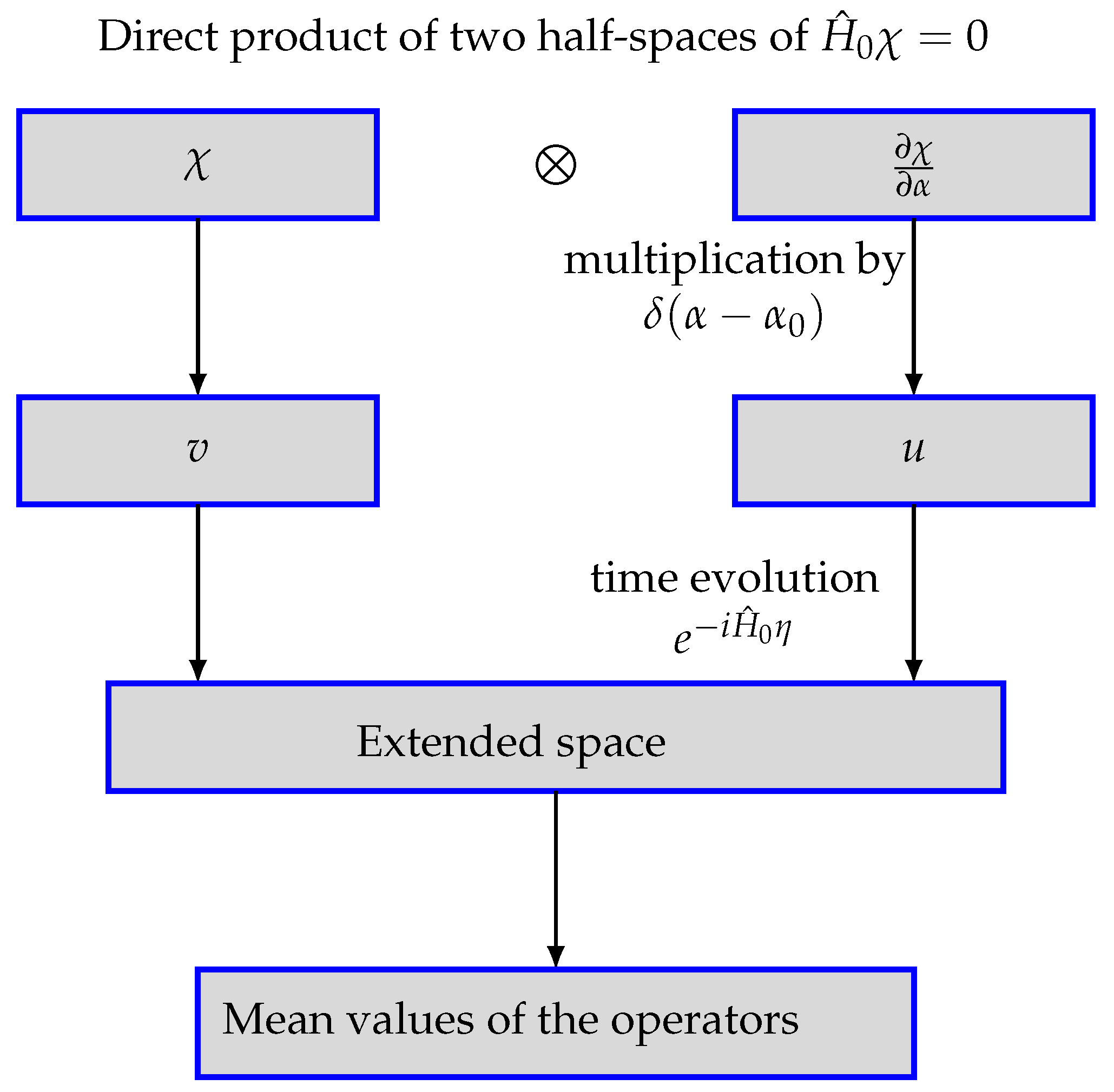Scalar Product for a Version of Minisuperspace Model with Grassmann Variables
Abstract
1. Introduction
2. The Etalon Picture with the Exclusion of the Redundant Degrees of Freedom
3. Evolution in Extended Space
4. Expectation Values of Scale Factor Degrees
5. Discussion and Conclusions
Author Contributions
Funding
Data Availability Statement
Conflicts of Interest
Appendix A. Generalized Hamiltonian Form of the Action with the Grassmann Variables
Appendix B. Quantization of a Particle-Clock

Appendix C. Removing of an “Extended Zitterbewegung”
| 1 | For instance, in a more general case, , and the conserved in time gauge-fixing condition = 0, physical Hamiltonian and . |
| 2 | The mean value of is singular at . Moreover, one may consider that the singularity stores information about the quantum state defined by the wave packet (see [48] for a general discussion). On the other hand, there is a “no-boundary” proposal for a non-singular origin of the universe (for a review, see [49]). |
| 3 | |
| 4 | |
| 5 |
References
- Gitman, D.; Tyutin, I.V. Quantization of Fields with Constraints; Springer: Berlin/Heidelberg, Germany, 1990. [Google Scholar]
- Henneaux, M.; Teitelboim, C. Quantization of Gauge Systems; Princeton Univ. Press: Princeton, NJ, USA, 1992. [Google Scholar]
- Dirac, P. Lectures on Quantum Mechanics; Belfer Graduate School of Science, Yeshiva University: New York, NY, USA, 1967. [Google Scholar]
- Hawking, S.W. Breakdown of predictability in gravitational collapse. Phys. Rev. D 1976, 14, 2460–2473. [Google Scholar] [CrossRef]
- Giddings, S. Black hole information, unitarity, and nonlocality. Phys. Rev. D 2006, 74, 106005. [Google Scholar] [CrossRef]
- Page, D.N. Information in black hole radiation. Phys. Rev. Lett. 1993, 71, 3743–3746. [Google Scholar] [CrossRef]
- Penington, G. Entanglement Wedge Reconstruction and the Information Paradox. arXiv 2020, arXiv:1905.08255. [Google Scholar] [CrossRef]
- Hashimoto, K.; Iizuka, N.; Matsuo, Y. Islands in Schwarzschild black holes. J. High Energy Phys. 2020, 2020, 85. [Google Scholar] [CrossRef]
- Akhmedov, E.K. Vacuum energy and relativistic invariance. arXiv 2002, arXiv:hep-th/0204048. [Google Scholar]
- Visser, M. Lorentz Invariance and the Zero-Point Stress-Energy Tensor. Particles 2018, 1, 138–154. [Google Scholar] [CrossRef]
- Barvinsky, A.O.; Kamenshchik, A.Y.; Vardanyan, T. Comment about the vanishing of the vacuum energy in the Wess-Zumino model. Phys. Lett. B 2018, 782, 55–60. [Google Scholar] [CrossRef]
- Cherkas, S.L.; Kalashnikov, V.L. An approach to the theory of gravity with an arbitrary reference level of energy density. Proc. Natl. Acad. Sci. Belarus Ser. Phys.-Math. 2019, 55, 83. [Google Scholar] [CrossRef]
- Cherkas, S.L.; Kalashnikov, V.L. Eicheons instead of Black holes. Phys. Scr. 2020, 95, 085009. [Google Scholar] [CrossRef]
- Carballo-Rubio, R.; Filippo, F.D.; Liberati, S.; Visser, M. Singularity-free gravitational collapse: From regular black holes to horizonless objects. arXiv 2023, arXiv:2302.00028. [Google Scholar]
- Haridasu, B.S.; Cherkas, S.L.; Kalashnikov, V.L. A reference level of the Universe vacuum energy density and the astrophysical data. Fortschr. Phys. 2020, 68, 2000047. [Google Scholar] [CrossRef]
- Visser, M. The Pauli sum rules imply BSM physics. Phys. Lett. B 2019, 791, 43–47. [Google Scholar] [CrossRef]
- Townsend, P.K. Aether, dark energy and string compactifications. Philos. Trans. R. Soc. A 2022, 380, 20210185. [Google Scholar] [CrossRef] [PubMed]
- Cherkas, S.; Kalashnikov, V. Æther as an Inevitable Consequence of Quantum Gravity. Universe 2022, 8, 626. [Google Scholar] [CrossRef]
- Burdík, Č; Navrátil, O. Dirac formulation of free open string. Univ. J. Phys. Appl. 2007, 4, 487–506. [Google Scholar]
- Meusburger, C.; Schonfeld, T. Gauge fixing in (2 + 1)-gravity: Dirac bracket and spacetime geometry. Class. Quant. Grav. 2011, 28, 125008. [Google Scholar] [CrossRef]
- Cherkas, S.L.; Kalashnikov, V.L. Quantum evolution of the universe in the constrained quasi-Heisenberg picture: From quanta to classics? Grav. Cosmol. 2006, 12, 126–129. [Google Scholar]
- Cherkas, S.L.; Kalashnikov, V.L. An inhomogeneous toy model of the quantum gravity with the explicitly evolvable observables. Gen. Rel. Grav. 2012, 44, 3081–3102. [Google Scholar] [CrossRef][Green Version]
- Cherkas, S.L.; Kalashnikov, V.L. Quantization of the inhomogeneous Bianchi I model: Quasi-Heisenberg picture. Nonlin. Phenom. Complex Syst. 2013, 18, 1–15. [Google Scholar]
- Cherkas, S.L.; Kalashnikov, V.L. Quantum Mechanics Allows Setting Initial Conditions at a Cosmological Singularity: Gowdy Model Example. Theor. Phys. 2017, 2, 124–135. [Google Scholar] [CrossRef]
- Faddeev, L.; Popov, V.N. Covariant quantization of the gravitational field. Sov. Phys. Usp. 1974, 16, 777–789. [Google Scholar] [CrossRef]
- Faddeev, L.; Slavnov, A. Gauge Fields. Introduction to Quantum Theory; Addison-Wesley Publishing: Redwood, CA, USA, 1991. [Google Scholar]
- Savchenko, V.; Shestakova, T.; Vereshkov, G. Quantum geometrodynamics in extended phase space—I. Physical problems of interpretation and mathematical problems of gauge invariance. Grav. Cosmol. 2001, 7, 18–28. [Google Scholar]
- Vereshkov, G.; Marochnik, L. Quantum Gravity in Heisenberg Representation and Self-Consistent Theory of Gravitons in Macroscopic Spacetime. J. Mod. Phys. 2013, 4, 285–297. [Google Scholar] [CrossRef]
- Upadhyay, S. Field-dependent symmetries in Friedmann–Robertson–Walker models. Ann. Phys. 2015, 356, 299–305. [Google Scholar] [CrossRef][Green Version]
- Chauhan, B. Quantum symmetries and conserved charges of the cosmological Friedmann-Robertson-Walker model. Eur. Phys. Lett. 2022, 140, 40001. [Google Scholar] [CrossRef]
- Ruffini, G. Quantization of simple parametrized systems. arXiv 2005, arXiv:gr-qc/0511088. [Google Scholar]
- Kleefeld, F. On some meaningful inner product for real Klein—Gordon fields with positive semi-definite norm. Czec. J. Phys. 2006, 56, 999–1006. [Google Scholar] [CrossRef]
- Cianfrani, F.; Montani, G. Dirac prescription from BRST symmetry in FRW space-time. Phys. Rev. D 2013, 87, 084025. [Google Scholar] [CrossRef]
- Lapchinskii, V.G.; Rubakov, V.A. Quantum gravitation: Quantization of the Friedmann model. Theor. Math. Phys. 1977, 33, 1076–1084. [Google Scholar] [CrossRef]
- Lemos, N.A. Radiation-dominated quantum Friedmann models. J. Math. Phys. 1996, 37, 1449–1460. [Google Scholar] [CrossRef]
- Mansouri, R.; Nasseri, F. Model universe with variable space dimension: Its dynamics and wave function. Phys. Rev. D 1999, 60, 123512. [Google Scholar] [CrossRef]
- Gryb, S.; Thébault, K.P.Y. Bouncing unitary cosmology I. Mini-superspace general solution. Class. Quant. Grav. 2019, 36, 035009. [Google Scholar] [CrossRef]
- Gielen, S.; Menéndez-Pidal, L. Singularity resolution depends on the clock. Class. Quant. Grav. 2020, 37, 205018. [Google Scholar] [CrossRef]
- Gielen, S.; Menéndez-Pidal, L. Unitarity, clock dependence and quantum recollapse in quantum cosmology. Class. Quant. Grav. 2022, 39, 075011. [Google Scholar] [CrossRef]
- Garay, L.J.; Halliwell, J.J.; Marugán, G.A.M. Path-integral quantum cosmology: A class of exactly soluble scalar-field minisuperspace models with exponential potentials. Phys. Rev. D 1991, 43, 2572–2589. [Google Scholar] [CrossRef]
- Bojowald, M. Quantum cosmology: A review. Rep. Progr. Phys. 2015, 78, 023901. [Google Scholar] [CrossRef]
- Balcerzak, A.; Lisaj, M. Spinor wave function of the Universe in non-minimally coupled varying constants cosmologies. arXiv 2023, arXiv:2303.13302. [Google Scholar] [CrossRef]
- Kaya, A. Schrödinger from Wheeler–DeWitt: The issues of time and inner product in canonical quantum gravity. Ann. Phys. 2023, 451, 169256. [Google Scholar] [CrossRef]
- Barvinsky, A.O.; Kamenshchik, A.Y. Selection rules for the Wheeler-DeWitt equation in quantum cosmology. Phys. Rev. D 2014, 89, 043526. [Google Scholar] [CrossRef]
- Cherkas, S.L.; Kalashnikov, V.L. Evidence of time evolution in quantum gravity. Universe 2020, 6, 67. [Google Scholar] [CrossRef]
- Ashtekar, A.; Bianchi, E. A short review of loop quantum gravity. Rep. Progr. Phys. 2021, 84, 042001. [Google Scholar] [CrossRef]
- Bojowald, M. Space-Time Physics in Background-Independent Theories of Quantum Gravity. Universe 2021, 7, 251. [Google Scholar] [CrossRef]
- Cherkas, S.L.; Kalashnikov, V.L. Cosmological Singularity as an Informational Seed for Everything. Nonlin. Phenom. Complex Syst. 2022, 25, 266–275. [Google Scholar] [CrossRef]
- Lehners, J.L. Review of the no-boundary wave function. Phys. Rep. 2023, 1022, 1–82. [Google Scholar] [CrossRef]
- Shestakova, T.P.; Simeone, C. The Problem of time and gauge invariance in the quantization of cosmological models. II. Recent developments in the path integral approach. Grav. Cosmol. 2004, 10, 257–268. [Google Scholar]
- Shestakova, T.P. Is the Wheeler-DeWitt equation more fundamental than the Schrödinger equation? Int. J. Mod. Phys. D 2018, 27, 1841004. [Google Scholar] [CrossRef]
- Shestakova, T.P. On the meaning of the wave function of the Universe. Int. J. Mod. Phys. D 2019, 28, 1941009. [Google Scholar] [CrossRef]
- Kaku, M. Introduction to Superstrings; Springer: New York, NY, USA, 2012. [Google Scholar]
- DeWitt, B.S. Dynamical Theory in Curved Spaces. I. A Review of the Classical and Quantum Action Principles. Rev. Mod. Phys. 1957, 29, 377–397. [Google Scholar] [CrossRef]
- Tagirov, E.A. On Ordering of Operators in Canonical Quantization in Curved Space. arXiv 2001, arXiv:quant-ph/0101016. [Google Scholar]
- Pavsic, M. How the geometric calculus resolves the ordering ambiguity of quantum theory in curved space. Clas. Quant. Grav. 2003, 20, 2697–2714. [Google Scholar] [CrossRef][Green Version]
- Mostafazadeh, A. Quantum mechanics of Klein-Gordon-type fields and quantum cosmology. Ann. Phys. 2004, 309, 1–48. [Google Scholar] [CrossRef]
- Acquaviva, G.; Iorio, A.; Pais, P.; Smaldone, L. Hunting Quantum Gravity with Analogs: The Case of Graphene. Universe 2022, 8, 455. [Google Scholar] [CrossRef]
- Castorina, P.; Iorio, A.; Satz, H. Hunting Quantum Gravity with Analogs: The Case of High-Energy Particle Physics. Universe 2022, 8, 482. [Google Scholar] [CrossRef]
- Shukla, A.; Singh, D.V.; Kumar, R. (Anti-)BRST Symmetries in FLRW Model: Supervariable Approach. arXiv 2023, arXiv:2309.14066. [Google Scholar]
- Silenko, A.J. Zitterbewegung of Bosons. Phys. Part. Nucl. Lett. 2020, 17, 116–119. [Google Scholar] [CrossRef]
- Lovett, S.; Walker, P.M.; Osipov, A.; Yulin, A.; Naik, P.U.; Whittaker, C.E.; Shelykh, I.A.; Skolnick, M.S.; Krizhanovskii, D.N. Observation of Zitterbewegung in photonic microcavities. Light Sci. Appl. 2023, 12, 126. [Google Scholar] [CrossRef]
- Costella, J.P.; McKellar, B.H.J. The Foldy-Wouthuysen transformation. Am. J. Phys. 1995, 63, 1119–1121. [Google Scholar] [CrossRef]
- Neznamov, V.P.; Silenko, A.J. Foldy—Wouthuysen wave functions and conditions of transformation between Dirac and Foldy—Wouthuysen representations. J. Math. Phys. 2009, 50, 122302. [Google Scholar] [CrossRef]
- Silenko, A.J. Exact form of the exponential Foldy-Wouthuysen transformation operator for an arbitrary-spin particle. Phys. Rev. A 2016, 94, 032104. [Google Scholar] [CrossRef]
- Menéndez-Pidal, L. The Problem of Time in Quantum Cosmology. Ph.D. Thesis, University of Nottingham, School of Mathematics, Nottingham, UK, 2022. [Google Scholar]

| 2 | 4 | 6 | 8 | 10 | 12 | 14 | |
|---|---|---|---|---|---|---|---|
| for the etalon model | |||||||
| for the model with the Grassmann variables |
Disclaimer/Publisher’s Note: The statements, opinions and data contained in all publications are solely those of the individual author(s) and contributor(s) and not of MDPI and/or the editor(s). MDPI and/or the editor(s) disclaim responsibility for any injury to people or property resulting from any ideas, methods, instructions or products referred to in the content. |
© 2023 by the authors. Licensee MDPI, Basel, Switzerland. This article is an open access article distributed under the terms and conditions of the Creative Commons Attribution (CC BY) license (https://creativecommons.org/licenses/by/4.0/).
Share and Cite
Cherkas, S.L.; Kalashnikov, V.L. Scalar Product for a Version of Minisuperspace Model with Grassmann Variables. Universe 2023, 9, 508. https://doi.org/10.3390/universe9120508
Cherkas SL, Kalashnikov VL. Scalar Product for a Version of Minisuperspace Model with Grassmann Variables. Universe. 2023; 9(12):508. https://doi.org/10.3390/universe9120508
Chicago/Turabian StyleCherkas, Sergey L., and Vladimir L. Kalashnikov. 2023. "Scalar Product for a Version of Minisuperspace Model with Grassmann Variables" Universe 9, no. 12: 508. https://doi.org/10.3390/universe9120508
APA StyleCherkas, S. L., & Kalashnikov, V. L. (2023). Scalar Product for a Version of Minisuperspace Model with Grassmann Variables. Universe, 9(12), 508. https://doi.org/10.3390/universe9120508








